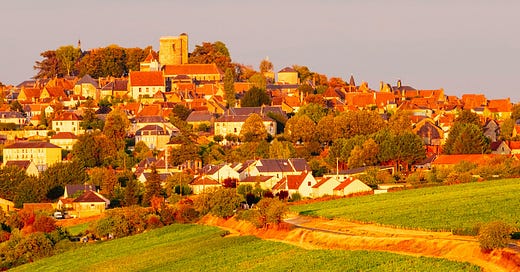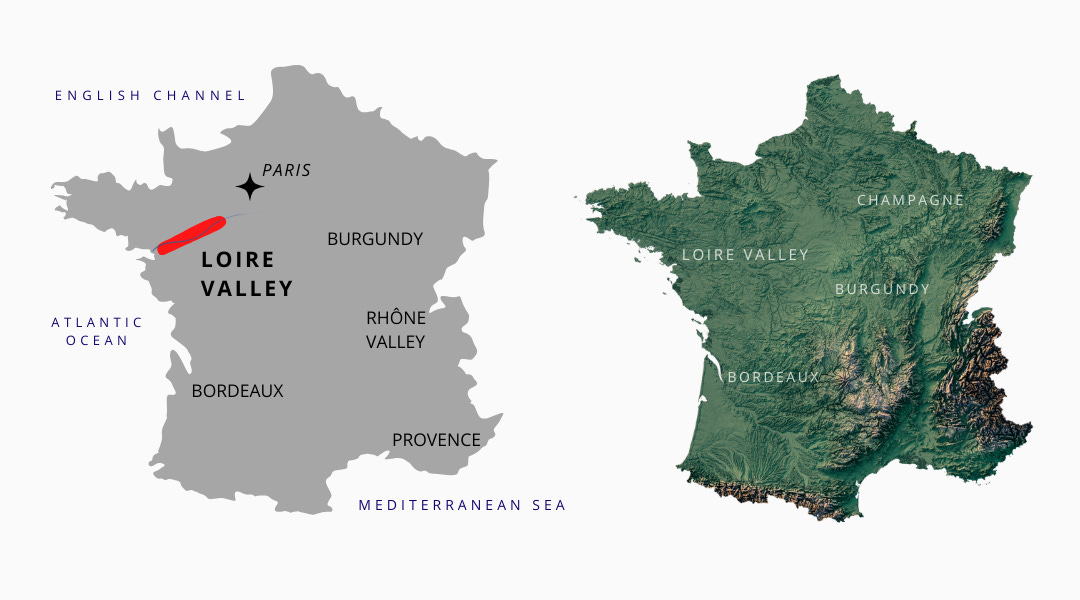The Loire Valley wine region, located in central France along the Loire River, is a sprawling, historic expanse that stretches from the Atlantic coast near Nantes to the heart of the country in the eastern vineyards of Sancerre. Known as the longest wine region in France, the Loire Valley encompasses a diverse range of microclimates, soil types, and vineyard sites that contribute to its reputation as one of the world’s most versatile wine-producing areas.
Its location along the Loire River plays a vital role in shaping the vineyards; the river moderates the climate, allowing for successful viticulture across both cooler and warmer areas. The valley itself is divided into several key regions: Pays Nantais, Anjou, Saumur, Touraine, and the Upper Loire, each of which offers unique grape varieties and winemaking styles that reflect the distinct terroirs of their locations.
The winemaking heritage of the Loire Valley dates back to Roman times, with significant expansion and development during the Middle Ages, as monasteries established vineyards and refined viticultural practices. By the time of the Renaissance, Loire Valley wines were highly favored by French nobility, who resided in the region’s famed châteaux and contributed to its status as a cultural and gastronomic hub. The Loire’s position as a wine trade route between the north and south of France helped establish its wines on a broader scale, making them accessible to foreign markets and cementing the region’s reputation for quality. This centuries-old legacy is reflected today in the Loire’s continued dedication to sustainable and organic farming practices, along with a commitment to preserving its unique viticultural history, making it a treasured part of France’s wine culture.
The Loire Valley is distinguished by its diversity of grape varieties, with several key regions like Sancerre, Chinon, and Vouvray leading the way in producing some of France’s most acclaimed wines. In Sancerre, located in the Upper Loire, the predominant grape is Sauvignon Blanc, known for producing crisp, mineral-driven wines with bright acidity and distinctive notes of citrus, green apple, and flint. The chalky limestone and silex (flint) soils of Sancerre contribute to the wine’s characteristic minerality, creating a unique expression that has garnered international renown. While Sauvignon Blanc dominates, Sancerre also produces a smaller quantity of Pinot Noir, which yields light, aromatic reds and rosés that reflect the region’s cool climate.
Finding off the beaten path wine regions to enjoy is a true pleasure of wine culture, and offers a way to explore history, geography and the tastes of a region that is steeped in timeless significance.
Chinon, situated in the Touraine sub-region, is best known for its Cabernet Franc, a grape that flourishes in the valley’s varied soil types, from limestone-rich tuffeau to gravel and sand along the riverbanks. Chinon’s Cabernet Franc wines are prized for their complexity and range, offering flavors of red and black fruits, green pepper, and earthy undertones, with a structure that allows for aging yet remains approachable when young. This versatility makes Chinon an essential part of the Loire’s red wine profile, showing the adaptability of Cabernet Franc in both lighter, fresher styles and fuller-bodied expressions.
Vouvray, also in Touraine, is synonymous with Chenin Blanc, a grape that achieves remarkable versatility depending on the climate, soil, and vinification methods used. Vouvray Chenin Blanc can range from dry and crisp (sec) to richly sweet (moelleux) and even sparkling (pétillant or mousseux). This range of styles allows Vouvray to capture the full potential of Chenin Blanc, producing wines with high acidity, notes of quince, apple, and honey, and a capacity for long aging. The limestone soils of Vouvray contribute to the wine’s freshness and complexity, allowing it to evolve beautifully over time. Together, these regions and their signature grapes demonstrate the Loire Valley’s ability to produce an array of wine styles that reflect the region’s rich terroir, making it one of France’s most celebrated and dynamic wine-producing areas.
The Loire Valley is not only defined by its iconic regions and celebrated grape varieties but also by a treasure trove of lesser-known areas that promise exciting discoveries for wine enthusiasts. Beyond Sancerre, Chinon, and Vouvray, the valley is filled with small appellations such as Muscadet in Pays Nantais, producing saline-driven white wines, or Saumur, which crafts complex reds and sparkling wines with finesse. These lesser-explored areas offer exceptional quality and outstanding value, often showcasing the same meticulous winemaking traditions and dedication to terroir that define the region's most famous names.
Exploring these hidden gems opens the door to classic French wines with unique character, making the Loire Valley not only a symbol of quality but also a landscape of endless possibilities. Whether seeking the familiar or the unexpected, wine lovers will find the Loire Valley a rewarding journey through some of France’s most expressive and affordable wines, each bottle a reflection of the region’s heritage and vibrant diversity.

















Share this post